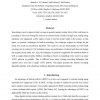Free Online Productivity Tools
i2Speak
i2Symbol
i2OCR
iTex2Img
iWeb2Print
iWeb2Shot
i2Type
iPdf2Split
iPdf2Merge
i2Bopomofo
i2Arabic
i2Style
i2Image
i2PDF
iLatex2Rtf
Sci2ools
88
Voted
VTS
2003
IEEE
2003
IEEE
Built-In Reseeding for Serial Bist
Reseeding is used to improve fault coverage in pseudo-random testing. Most of the work done on reseeding is based on storing the seeds in an external tester. Besides its high cost, testing using automatic test equipment (ATE) makes it hard to test the circuit while in the system. In this paper, we present a technique for built-in reseeding. Our technique requires no storage for the seeds. The seeds are encoded in hardware. The seeds we use are deterministic so 100% fault coverage can be achieved. Our technique causes no performance overhead and does not change the original circuit under test. Also, the technique we present is applicable for transition faults as well as single-stuck-at faults. Built-in reseeding is based on expanding every seed to as many ATPG patterns as possible. This is different from many existing reseeding techniques that expand every seed into a single ATPG pattern. This paper presents the built-in reseeding algorithm together with a hardware synthesis algorithm ...
| Added | 05 Jul 2010 |
| Updated | 05 Jul 2010 |
| Type | Conference |
| Year | 2003 |
| Where | VTS |
| Authors | Ahmad A. Al-Yamani, Edward J. McCluskey |
Comments (0)

